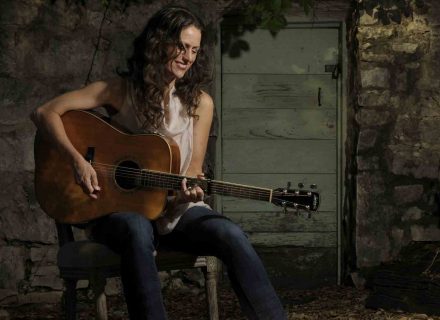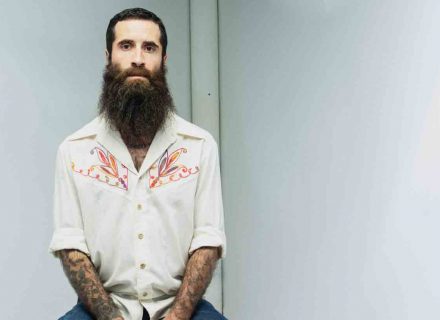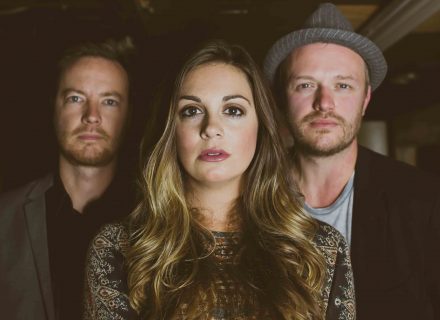Matt Bivins talks about Jump, Little Children’s first album in 14 years, Sparrow.
After 14 years apart, Jump, Little Children is back with their latest album, Sparrow, available now.
On their ninth album, the band members — Evan Bivins, Matt Bivins, Jay Clifford, Jonathan Gray, and Ward Williams — help themselves liberally to sounds from their past records and punch up the production values. The captivating sound is pure Jump, Little Children.
After a long hiatus apart filled with individual projects and a few reunion shows, the band solidify their musical maturity on Sparrow, rejuvenating their sound and musical harmony.
Album highlights include the title track, which talks about returning to what you love; the ethereal and tonic “X-Raying Flowers”; and the sultry “White Buffalo.”
Recently, we talked with Matt Bivins about Jump, Little Children’s return, their time apart, and what we can expect in the future.
Cowboys & Indians: Your latest record, Sparrow, is your first music together after 14 years. What was it like for you all to come back on the music scene as a group?
Matt Bivins: Right, as a group. That’s interesting that you ask because the title track, “Sparrow,” is partly about that feeling. That feeling of being a part of the music world, the music scene, and having this community, just sort of making it your life for 14 years before and then suddenly taking a break from all of it — from putting content out into the world and from being a part of that world and just sort of trying other things for 10 years and then coming back to it. That’s partly what “Sparrow” is about, the fragility of, you know, what if I could be in a rock band and what it’s like to be a part of something and then not. It feels amazing because I feel like we have taken all of the things that we’ve learned on our hiatus and applied them to Sparrow, all of the different things we’ve tried, all the new levels of musicianship or theatricality and brought it to Sparrow. It feels great.
C&I: After a 14-year hiatus, what do you hope your fans will take away from the new album?
Bivins: Our hope has been that, number one, the fans that have stuck around with us, which is always an incredulous thing for us, that they’ll find nods to things that they can relate to. It seems like a lot of our fans have different ideas of what the band is and what we sound like and certainly what Jump, Little Children is to them. I think that Sparrow has little bits of all those things that made us who we are, and so the main thing we hope is that the fans like it.
The next thing is to try to pass the album on so that we can meet some new fans and make some new fans. That’s also going to be important.
C&I: What was it like for you guys to get together again and start producing music? Any fun stories?
Bivins: Yeah. Even in 2015, when there was just a reunion show, we weren’t really thinking about new music originally, but the second that we all walked into the rehearsal space, we started laughing and bringing up old jokes. I mean, there’s a reason that we were the best coworkers, friends, and brothers ever, and that’s still the case. But the interesting thing about Sparrow is that we’ve never made an album like this. We’ve always been a live band. We’ve always toured and toured and toured. So we would learn new songs on the road, every single time, and they will have been played live a good month or two before we ended up recording those songs. So we would walk into the studio and kind of know our parts and add some things here and there. This is the first time that we didn’t know any of the songs when we walked into the studio.
So a couple of really fun things about that is that we really took these demos that Jay had come up with and I had written a little bit as just that — just demos, just ideas. And we sat around and it was really kind of like the first rehearsal learning every single song, except we were also recording. It was really freeing and exciting in that way. A big, big, big part of this process for us was the producer of most of the songs was Josh Kaler. To have a producer have such a role in arrangement and reconfiguring and finding the essence of every song — it’s a much more fun way to do it, honestly.
C&I: That’s cool that you all wrote songs while on the road. How do you guys approach songwriting? Do you start with the lyrics first or the music?
Bivins: It kind of depends. There have been albums where lyrics have been written first and then music, but I think, in general, the way that Jay works is that he kind of puts it together all at once. But this time, since no one was in the same room as the demos were being written — we were all in different cities — we had a dropbox and we would put a song in and Jay would say, “Hey man, I need some extra lyrics on this song.” So the songs that got onto this album, Jay had music first and I would write to songs that were partly built. That was fun, because he would have maybe a chorus and a concept of a chorus and I would have to sort of guess the feeling of the song and add to it on my own. I think that, in general, he did lyrics and music all at once and just holed up in his video practice space and just kind of wrote a bunch of stuff. We all did.
C&I: You guys have such a diverse sound, with some dark elements, electronic distortions, with a little bit of Celtic origins. It’s kind of hard to pin down. If someone were to ask you about your music, how would you describe your sound?
Bivins: I’ve been saying, recently — and it’s funny because other people have been saying it too — but there’s sort of a [term] “chamber pop” that gets thrown around. And I feel like in the sense that we’ve always had songs that are very quote-unquote “orchestrated,” even when there were or were not strings, you know, when you’re dealing with a cellist and a guitarist, there’s a very art-school thing that we’ve always had. So like an “art school chamber pop” kind of fit us.
C&I: How would you say you guys developed that sound?
Bivins: I really think the biggest part of it is that we all went to a conservatory in North Carolina. I think the bass player went to his own, but he also studied music in South Carolina. Jay went to school for guitar. I was there as a clarinet player, but composition was a big part of what we learned. And when we started as an Irish music band, that music is very structured and arranged and I just think we never got out of that idea. We were never a jam band, so it wasn’t the kind of thing where we would sit around and just make noises. It’s always been a very classical music/art school way of thinking.
C&I: Did you all ever go through a trial-and-error process where one of you would play something and another would complement it with another instrument and it didn’t really work?
Bivins: Oh, absolutely. There’s a song on the album called “White Buffalo” and Jay’s original demo is banjo. He just had a banjo lying around. … He had the melody in his head, but he didn’t know exactly what instrument and he just grabbed that one. So the original demo has this banjo and it’s very prominent. We always knew that we were going to change that. We were never going to have a banjo, and … when we got to Charleston and worked with Wolfgang Zimmerman, we kept trying to find the instrument that was going to play that line. The line was solid, so we tried cello. We tried accordion. Nothing was really sounding right, and then Jay went home one day and he has this really weird, weird old piano that just sounds dark and something’s very weird about his piano. He played the line and recorded it from his house and it was the perfect thing to the point where we sampled his piano and took it on the road this time. It’s actually Jay’s piano … but it was the perfect sound for “White Buffalo.”
C&I: How do you feel your music has evolved during those years apart? After opening studios, composing for Broadway, and composing for orchestras, was it difficult to jump right back in?
Bivins: I thought that it was going to be really difficult. I thought it was going to be hard, but it really hasn’t been. I personally have probably played the least amount of music in the last 14 years. I’ve been more of an actor, a performer, but I think everyone found that the things that they were comfortable with in the past were still there and the things that they had newly learned were only these really great additions. I think that the music is more mature. I think that’s fair to say — it’s more mature. It’s not necessarily the heavier part of Magazine, but it’s also a little bit more accessible than something like Vertigo, and it’s not a completely Celtic album. You know it’s not as folky and I feel that’s because we’ve grown to appreciate the concept of trying to make something more cohesive. I feel like we don’t mind working and using our strengths more. And those strengths have just changed with age. I think lyrically, there’s so much more to talk about after 10 years away. There’s children being born or experiences being had, falling in love, and all these things you could talk about. I think we’re a more mature band. That feels really good and not in an “Oh man, we’re getting old” way.
C&I: Is there a track on the album that you’re most proud of?
Bivins: I think I’m more proud of this album than any one before it. I truly still love listening to it, which is not always the case for me. … But I love how “Cyclorama” came out. The original demo was not one of my favorites, but the song came together in such a wonderful way. I love playing it live. It’s definitely my favorite song to play live.
C&I: Now that you guys are on tour, what can we expect from the shows? Anything really special?
Bivins: I can’t talk too much about the December shows, but I will hint that there’s an extremely good chance that we’re going to be able to add some of the orchestration, the string parts, the more orchestrated parts on the album, into a live setting. Also, the songs themselves that we play live, the new ones for the new album, are so different because we, as a band, had never “chased” the album sounds. We’ve sort of had a live version of a song on an album and then the studio version, but this is the first tour where we’re really trying to get the actual sounds, samples. I play a keytar on stages, so it’s all about sort of ... I want Jay’s piano, I want the piano on the album, and we want certain things so that when someone who knows the album Sparrow it’s going to sound as close to that as it can be with the additional excitement of being there live. So we’re really having fun with that.
For more information and upcoming tour dates on Jump, Little Children, and to order their new album, visit their website.

















